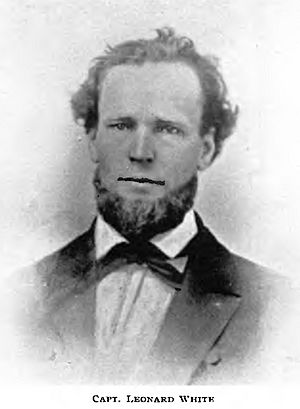Forty-Nine (steamboat) facts for kids
The Forty-Nine was a steamboat that sailed the waters of what is now the West Kootenay area in southeastern British Columbia. It operated from the mid-1860s to the early 1870s.
Contents
Building the Steamboat Forty-Nine
During the Big Bend Gold Rush, people needed a way to travel to the goldfields. There weren't enough boats to carry everyone and their supplies. To help with this, the Forty-Nine was built. Its engine came from an older steamboat called the SS Jennie Clark, which was built in 1855. The Forty-Nine was launched in November 1865, which meant it missed most of the busy gold mining season that year.
Why the Name Forty-Nine?
The steamboat was built about 18 miles (29 km) south of the border between Canada and the United States. This border is often called the "49th parallel" because it mostly follows the 49th line of latitude. So, the boat was named Forty-Nine after this border.
Every trip the steamboat made would cross this border. It traveled to a busy town called La Porte. This town was a main stopping point at the start of the Dalles des Morts, also known as "Death Rapids." This part of the river was close to the goldfields on the Goldstream River and other nearby creeks.
Journeys of the Forty-Nine
First Trip and Winter Ice
On its very first trip, Captain Leonard White took passengers and cargo north. They traveled up the Columbia River and into the Arrow Lakes. But about halfway to La Porte, thick winter ice blocked their way. The boat couldn't break through the heavy ice in the narrow passage between the two Arrow Lakes. So, the passengers had to get off, and the boat turned back south.
Breaking Through Ice in 1866
In April 1866, Captain White tried again. He headed north with 73 passengers and 15 tons of freight. To break through the ice on Upper Arrow Lake, they nailed boards to the front of the boat. This helped it act like an ice-breaker. After five or six miles, they reached clear water. Other river ice they met later was easier to get through.
The boat charged passengers $25 each, and freight cost $200 per ton. That first season, the money they earned paid for the entire steamboat! The journey of 265 miles (426 km) to La Porte took 10 days. The gold rush ended that year. There are different stories about how many trips the Forty-Nine completed from Marcus, Washington Territory. Some say three, some say four, and others say 37.
Later Voyages and Challenges
The last trip heading south from La Porte reportedly carried only three passengers who paid. However, miners who couldn't afford the fare were given a free ride. On this trip, the boat hit a floating log near Little Dalles, Washington. This ended the season, and the boat was docked for repairs near the Colville River, close to Marcus.
In November 1867, the Forty-Nine made one trip to the Big Bend area and returned with 90 miners. Only one trip happened the next year.
The steamboat also traveled to other places where gold was found. For example, it went to Forty-nine Creek near Nelson, British Columbia. In 1869, Captain White retired because he was not well. His First Mate, A.F. Pingston, took over as captain. That fall, the steamboat got stuck near Steamboat Riffle in the Big Bend area.
It was refloated in 1870 and brought south for repairs. After that, it operated off and on. For instance, in November 1871, it helped supply the Canadian Pacific Railway survey. This survey was a project to map out a route for the railway through the Selkirk Mountains, led by Walter Moberly. The Forty-Nine made its final trip to La Porte around that time.
No known pictures of the Forty-Nine steamboat exist today.


